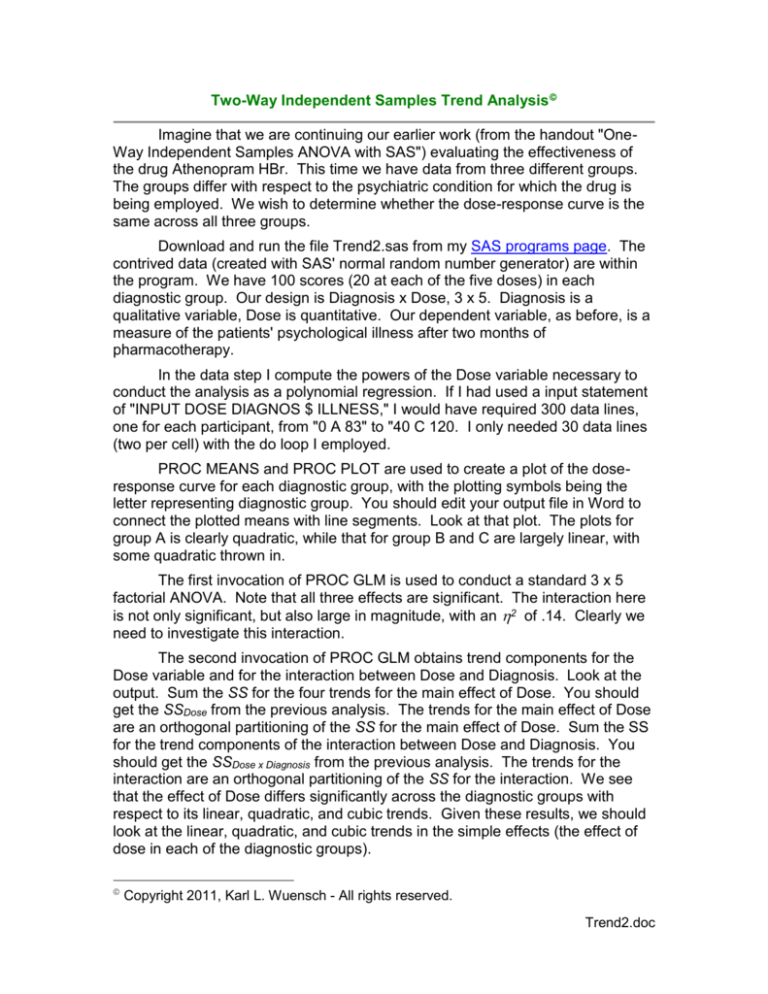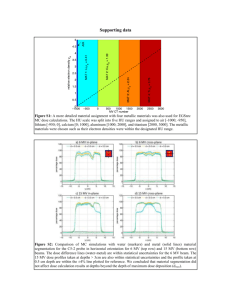
Two-Way Independent Samples Trend Analysis
Imagine that we are continuing our earlier work (from the handout "OneWay Independent Samples ANOVA with SAS") evaluating the effectiveness of
the drug Athenopram HBr. This time we have data from three different groups.
The groups differ with respect to the psychiatric condition for which the drug is
being employed. We wish to determine whether the dose-response curve is the
same across all three groups.
Download and run the file Trend2.sas from my SAS programs page. The
contrived data (created with SAS' normal random number generator) are within
the program. We have 100 scores (20 at each of the five doses) in each
diagnostic group. Our design is Diagnosis x Dose, 3 x 5. Diagnosis is a
qualitative variable, Dose is quantitative. Our dependent variable, as before, is a
measure of the patients' psychological illness after two months of
pharmacotherapy.
In the data step I compute the powers of the Dose variable necessary to
conduct the analysis as a polynomial regression. If I had used a input statement
of "INPUT DOSE DIAGNOS $ ILLNESS," I would have required 300 data lines,
one for each participant, from "0 A 83" to "40 C 120. I only needed 30 data lines
(two per cell) with the do loop I employed.
PROC MEANS and PROC PLOT are used to create a plot of the doseresponse curve for each diagnostic group, with the plotting symbols being the
letter representing diagnostic group. You should edit your output file in Word to
connect the plotted means with line segments. Look at that plot. The plots for
group A is clearly quadratic, while that for group B and C are largely linear, with
some quadratic thrown in.
The first invocation of PROC GLM is used to conduct a standard 3 x 5
factorial ANOVA. Note that all three effects are significant. The interaction here
is not only significant, but also large in magnitude, with an 2 of .14. Clearly we
need to investigate this interaction.
The second invocation of PROC GLM obtains trend components for the
Dose variable and for the interaction between Dose and Diagnosis. Look at the
output. Sum the SS for the four trends for the main effect of Dose. You should
get the SSDose from the previous analysis. The trends for the main effect of Dose
are an orthogonal partitioning of the SS for the main effect of Dose. Sum the SS
for the trend components of the interaction between Dose and Diagnosis. You
should get the SSDose x Diagnosis from the previous analysis. The trends for the
interaction are an orthogonal partitioning of the SS for the interaction. We see
that the effect of Dose differs significantly across the diagnostic groups with
respect to its linear, quadratic, and cubic trends. Given these results, we should
look at the linear, quadratic, and cubic trends in the simple effects (the effect of
dose in each of the diagnostic groups).
Copyright 2011, Karl L. Wuensch - All rights reserved.
Trend2.doc
The third invocation of PROC GLM is used to conduct a trend analysis for
each diagnostic group. Do notice that I excluded the quartic trend from the
models, given that our earlier analysis indicated that it was both trivial and not
significant. We see that in Group A, there is a strong (2 = .15) and significant
quadratic trend, and a weak (2 = .03) but significant cubic trend. The cubic
component is so small that we should not be surprised if we can see no sign of it
when we look at a plot of the means or a plot of the predicted values from the
cubic regression model. PROC GLM also gives us the intercept and slopes for
the cubic regression equation. You should ignore the p values that accompany
these -- they are for Type III sums of squares. With Type III sums of squares,
any overlap between predictors is not counted any predictor's sum of squares.
Our predictors are powers of the dose variable, which, of course, are highly
correlated with one another, making Type III sums of squares not appropriate.
In Group B, the linear trend is large (2 = .18) and significant, and the
quadratic trend is small (2 = .03) yet significant. In Group C, the linear effect is
very strong (2 = .31) and significant, and the quadratic effect small (2 = ..03)
yet significant.
I used PROC REG to obtain the regression coefficients and a plot of
regression line for a quadratic model for each diagnostic group. Inspecting these
plots should give you a better understanding of the quadratic functions,
especially if you 'connect the dots.’
Finally, I used Gplot to make an interaction plot with smoothed lines. Proc
Plot makes pretty clunky plots. Use Gplot or Excel to produce better looking
plots.
Results
<Table of Means and Standard Deviations>
Cell means and standard deviations are shown in Table 1. A factorial
trend analysis (Dose x Diagnosis) was conducted to determine the effects of
dose of Athenopram in each diagnostic group of patients at the Psychiatric
Institute for Abused Cuddly Toys (Psychiatrie für misshandelte Kuscheltiere). As
shown in Table 2, the interaction between dose of drug and diagnostic group was
both statistically significant and large in magnitude. The diagnostic groups
differed significantly with respect to the linear, quadratic, and cubic components
of dose of Athenopram. The simple effects of dose of Athenopram were tested
within each diagnostic group. Among patients diagnosed with illness A, there
was a significant quadratic trend, F(1, 96) = 17.97, p < .001, 2 = .15, and a
significant cubic trend, F(1, 96) = 4.10, p = .046, 2 = .03. As shown in Figure 1,
remission of symptoms of patients with this diagnosis was greatly reduced by the
10 mg dose, but the effectiveness of the Athenopram decreased with increases
in dose beyond 10 mg. Among patients with condition B, the linear effect of dose
was large and significant, F(1, 96) = 23.09, p < .001, 2 = .18, and the quadratic
effect was small but significant, F(1, 96) = 4.08, p = .046, 2 = .03. In this group
the 10 mg treatment aggravated the patients' illness, but larger doses were
effective in reducing symptoms, with effectiveness a linear function of dosage.
Among patients with diagnosis C, there was a very strong and significant linear
effect of dosage F(1, 96) = 44.59, p < .001, 2 = .31, and a small but significant
quadratic trend, F(1, 96) = 4.29, p =.041, 2 = .03. For these patients, every
increase in dosage was accompanied by a decrease in symptoms.
Table 2: Trend Analysis
df
F
p
Effect
Diagnosis
2
3.50
.031
Dose
4
11.60 < .001
Linear
1
40.59 < .001
Quadratic
1
5.53
.019
Cubic
1
0.26
.612
Quartic
1
0.00
.958
Interaction
8
6.67 < .001
Linear
2
13.27 < .001
Quadratic
2
10.05 < .001
Cubic
2
3.12
.046
Quartic
2
0.23
.79
Error
285
2
.02
.12
.10
.02
.00
.00
.14
.07
.05
.02
.00
Dose-Response for Athenopram in Cuddly Toys
Illness
110
100
90
80
70
0
5
10
15
20
25
30
Dose
Diagnosis
A
B
C
Copyright 2011, Karl L. Wuensch - All rights reserved.
35
40







